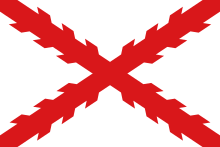Víctor Eusa Razquin
Víctor Eusa Razquin (1894–1990) was a Spanish architect, active almost exclusively in Navarre; he left his personal mark on Pamplona, which hosts numerous prestigious and monumental buildings he designed.
[4] Víctor's father, Salustiano Eusa Goñi (1852-1919) was born already in the Navarrese capital; in 1889 he married Tomasa Razquin Ijurco (1862-1958) from Arruazu.
[5] Eusa Goñi worked as administrator of estates, held by local landholders and aristocrats; his customers were e.g. the former mayor of Pamplona José Javier Colmenares Vidarte and Condesa de Ripalda.
Over time he grew to wealth; while in the early 1880s there were no possessions registered against his name, in the 1910s he was known as “rico propietario”, categorized as member of “clases pasivas”[6] and ranked 44. on the list of key taxpayers of the city.
[9] They were raised in a family considered typical for Pamplonese bourgeoisie of the late 19th century, tending to conservative outlook, adhering to traditional values, and profoundly Catholic.
[15] Her father ran a sugar mill in the Cuatro Vientos district[16] and later developed it into the alcohol and vinegar business;[17] he also served as councilor in the Pamplona town hall.
[37] Some 30 projects designed for travel & leisure industry cover hotels, casinos, cinemas, tennis clubs, concert halls or tourist shelters.
[41] Finally, general urban projects include parks, gardens, bus stations, plazas, viewpoints, monuments, a tunnel and a bridge.
[50] Basilica of Nuestra Señora del Puy in Estella turned an essay in geometry (1929),[51] while residential multi-dwellings at Plaza Príncipe de Viana marked his urbanistic capacity (1930).
[53] The first project of the Republican era was perhaps Eusa's most important work, usually listed first among his designs: Seminario Conciliar de San Miguel (1931).
Its giant cross on the front facade spoke volumes at the time when newly adopted law prohibited presence of religious symbols in public space.
[56] Eusa returned to major projects with schooling establishments in Zudaire and Fuenterrabia (1933),[57] and then with crèche of San Manuel in Tafalla, designed with adjacent church.
[64] In 1940-1941 Eusa joined forces with José Yárnoz to design Monumento a los Caidos, a monumental construction which jointly with re-arrangement of the quarter was intended as Pamplona's landmark.
[65] Following a number of refurbishment projects[66] new masterpiece works were Casa Consistorial in Olite (1945), the Coliseo theatre in Eibar (1949), and the headquarters of the insurance company Aurora, a 10-storey corner building (1949).
[74] Others also admit brief regionalist leaning, but categorize it as “episodes” falling on the early 1930s and prefer to quote colonias escolares in Zudaire and Fuenterrabia (1933),[75] works classified by others rather as marked by “romanticismo”.
[76] The mid-1920s is viewed as the period of prevailing secessionist influence of the Vienna branch, marking the Immaculada convent, Casa de Misericordia or the Alcoy bridge.
[82] Afterwards and well into the late 1930s Eusa underwent a “rationalist evolution”, demonstrated by utilitarian turn to residential buildings in the Pamplonese II Ensanche and in the San Juan clinic.
In terms of interior design scholars note that Eusa was among architects who mastered electric lighting, applied in different and ingenious ways.
The result is not only enhanced functionality but also the look of his buildings after dark, e.g. the landmark role of Casino Eslava in the centre of Pamplona, patios and internal yards of Casa de Misericordia, or cross of San Miguel, originally visible for tens of kilometers in the countryside north-east of the city.
[97] During works on Casa de Misericordia Eusa frequently interfaced with its administrator, Blas Inza Cabasés, a Carlist militant.
[99] From this moment Eusa underwent political radicalization and some time afterwards joined Carlist organization in Pamplona and facilitated its operations, e.g. by enabling access to premises in some buildings.
[104] There is little known of Eusa's engagement in Carlist structures in late 1936 and early 1937; some claim he was co-responsible for arrests carried out in Navarre and decided the fate of detainees.
[106] The exception was a giant altar, drafted probably in the fall of 1936; the construction was to be erected at the Madrid Puerta del Sol plaza, as the city was expected to be soon taken by the Nationalists.
[107] It is known that in the spring of 1937 Eusa was taking part in sittings of the Navarrese junta when discussing the threat of forced amalgamation into a state party; details of the position he took are not clear.










